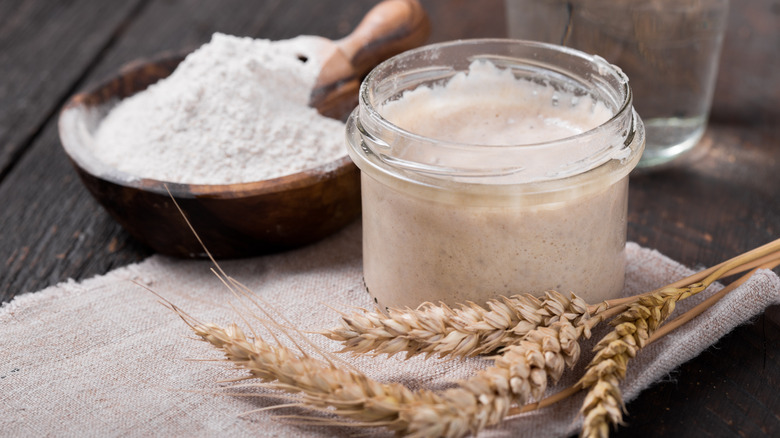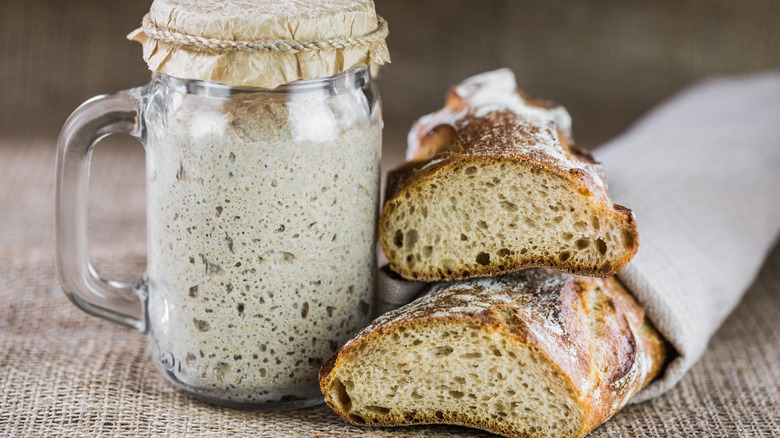The Longtime Connection Between Alaska And Sourdough
Pain de mie, rye, panettone, Irish soda — whatever the type, pretty much everyone has ties to bread. Whether it's a holiday specialty, religiously based, or just a memory shared around the dinner table, bread has been a familiar household favorite for centuries. And at one point, before the birth of agriculture, it was even a lifeline for human civilization.
According to NPR, this starchy love affair began over 14,400 years ago, when evidence of the world's first bread appeared in Jordan. In 2018, Amaia Arranz-Otaegui was uncovering and studying scraps of food left in a prehistoric fire pit when she came across what closely resembled burnt bread crumbs. This chance finding was a landslide discovery that illustrated the convergence of human creativity and resourcefulness.
Since then, much like human evolution, bread has developed, transformed, and expanded across the globe, with countless symbolic natures and traditions. This was especially true of sourdough bread, a valuable and cherished food that aided in the survival of Alaskan travelers in the 19th century.
Sourdough and the Klondike Gold Rush
Why did Alaska stick with sourdough? Why not bannock ("fry bread") or rye, two types of bread that have historical ties to surrounding Canadian regions? The answer lies within the Klondike Gold Rush of the late 1890s.
"It's the history of all those who came to try their luck at the wilds of Alaska, just surviving off their bag of flour. It's part of us," Alaskan resident and restaurant owner Trisha Costello told Atlas Obscura in 2021.
Sourdough, a leavened bread that depended solely on flour and water, was a staple for gold-seekers traveling west. Compared to other traditional bread, sourdough was cheap to make. It did not require perishable ingredients such as commercial yeast, eggs, and dairy that were far too expensive to purchase. In 1890, a single batch of Grade-A eggs cost $0.21, according to the Consumer Price Index through The San Diego Union-Tribune. In 2022, that equaled $6.45, per the U.S. Bureau of Labor Statistics.
This bread was easy to make thanks to the fermented mixture of flour and water, also known as sourdough starter (per The Clever Carrot). Like commercial yeast, this leavening agent allowed the bread to rise naturally. If fed properly and kept at warmer temperatures, sourdough starter can last for a very long time — even for more than 4,500 years. In 2019, a loaf of sourdough bread was successfully baked from ancient Egyptian yeast that had been harvested and grown into a starter, per Smithsonian.
'Sourdough' is an honorable title
When food was scarce, sourdough could keep families fed and alive for weeks, if not months or years. But some obstacles had to be overcome to achieve this long-lasting shelf life. According to King Arthur Baking, two serious issues can ruin or kill sourdough starter: inadequate temperatures and mold. To remain active and continue growing, sourdough starter needs heat — something Alaska has never been known for. Because sourdough starter is a culture of good bacteria, it is essential to nurture it and be attentive to keep invading bacteria out and stave off mold growth.
To avoid this, travelers and miners had to take great measures and treat the starter like their own. Per Atlas Obscura, over the years, the term "sourdough" extended past its carby origins and into a symbol of perseverance. It symbolized endurance and adaptability, an honorable title given to those who could survive Alaskan winters and thrive in adversity.
However, you don't need to live in Alaska to enjoy the century-old original sourdough bread recipe. And because of the sourdough starter's shelf life, some can even enjoy the 1890s starter in its initial form. According to the BBC, Arianna Sikorski, founder of Taste My Culture, claims to have inherited a historic sourdough starter that's survived three lifetimes and continues to produce bread today.


